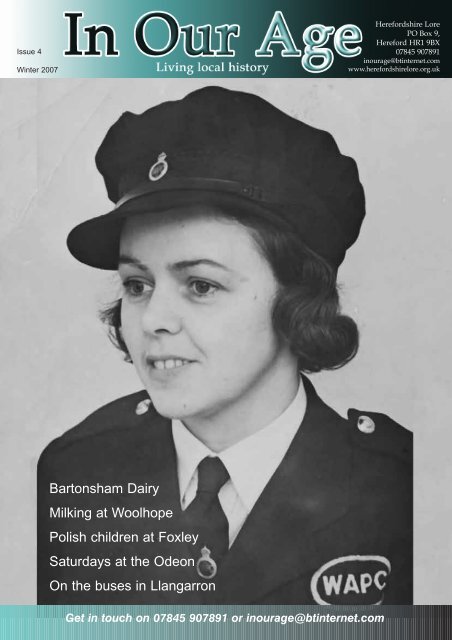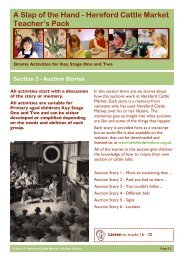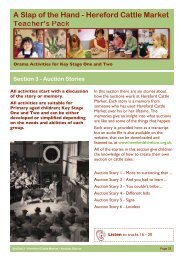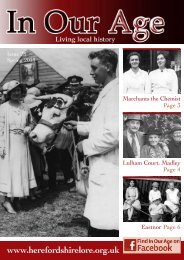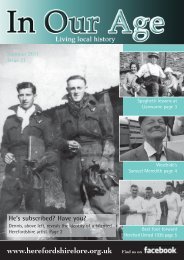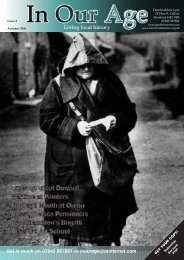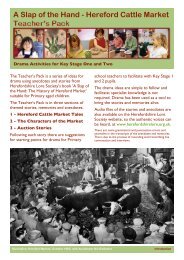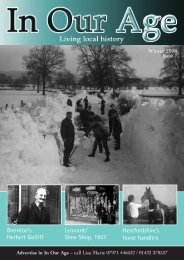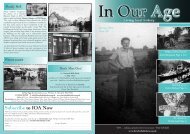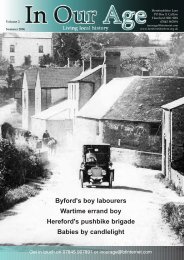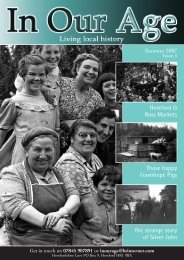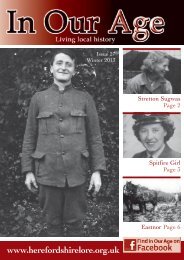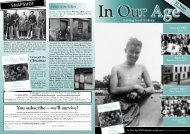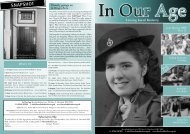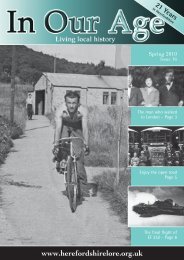Issue 4: Winter 2007 - Herefordshire Lore
Issue 4: Winter 2007 - Herefordshire Lore
Issue 4: Winter 2007 - Herefordshire Lore
Create successful ePaper yourself
Turn your PDF publications into a flip-book with our unique Google optimized e-Paper software.
<strong>Issue</strong> 4<br />
<strong>Winter</strong> <strong>2007</strong><br />
<strong>Herefordshire</strong> <strong>Lore</strong><br />
PO Box 9,<br />
Hereford HR1 9BX<br />
07845 907891<br />
inourage@btinternet.com<br />
www.herefordshirelore.org.uk<br />
Bartonsham Dairy<br />
Milking at Woolhope<br />
Polish children at Foxley<br />
Saturdays at the Odeon<br />
On the buses in Llangarron<br />
Get in touch on 07845 907891 or inourage@btinternet.com
Hereford Market<br />
People would dress up for Market<br />
When agricultural merchant Michael Ball from Eaton Bishop<br />
first started going to Hereford Market from Madley in the<br />
1940s, he often hitched a ride with Mr Breeze of Wormsley, a<br />
great character who always wore britches to Market.<br />
People would dress up for Market. Farmers would have their<br />
shoes and boots polished and wear their best britches and<br />
leggings while, in the Butter Market, some women were renowned<br />
for their hats.<br />
Mr Breeze had a horse and float, a two-wheeler trap with one<br />
axle. Mr Breeze’s wife and daughter, off to sell chickens or butter<br />
in the Butter Market would sit at the front. Mr Ball would put his<br />
piglets in the back, throw a net over them and sit above the wheel.<br />
There would be a line of horse and carts at Whitecross queuing<br />
for the Market. Livestock was deposited at the Market and the<br />
horse left with the stable boy at the Horse and Groom or other<br />
pubs with stabling. Everyone met at the temperance cafe, the<br />
Deanlea, for strong tea and a gossip. At the end of market day<br />
some farmers who had thrown temperance to the wind and were<br />
the worse for wear with drink, were put up in their traps and with a<br />
slap on the horse’s behind, sent off home.<br />
The Butter Market, selling flowers, butter and dressed chickens,<br />
was always busy on Wednesdays. Michael Ball recalls taking<br />
rabbits they’d shot or caught with ferrets into the Butter Market on<br />
his bike. “I used to carry rabbits on a stick on the handlebars.”<br />
One of Britain’s busiest markets<br />
Michael Ball; “The Market’s<br />
temperance cafe was a popular meeting<br />
place.” (photo: Bobbie Blackwell)<br />
It’s all about the relationship<br />
between man and his animals<br />
Auctioneers Julian Gallimore and Terry Court<br />
from Brightwells shared their memories of<br />
Market days with Bill Laws.<br />
“Hereford Market was a fantastic place,” says<br />
Terry who started his working life in the mid 1950s<br />
selling horse tack at the Market. “It was a five-daya-week<br />
operation. We would have anything up to<br />
3,000 or 4,000 fat sheep on a Monday and 500<br />
pigs and 600 fat cattle. Tuesday we’d have 600<br />
bulls or 200 horses. On a Wednesday we’d have<br />
12,000 sheep, 1,000 pigs, 600 calves, 500 young<br />
cattle and then on a Thursday anything up to<br />
2,000 store cattle, up to 600 barren cows and 400<br />
dairy cows on a Friday so it was a busy old place.”<br />
Julian agreed. “At one time the Market had<br />
the biggest turnover of any council-owned<br />
market in the country,” he said. “The whole<br />
Market was about the relationship between<br />
man and his animals and it was a wonderful<br />
relationship.”<br />
Both recall the great days when pedigree<br />
Herefords went on sale. “People came from<br />
all over the world to the January bull sale,”<br />
recalls Terry. “There was one taxi man<br />
called Len Oliver who did nothing else<br />
before and after the sale but taxi South<br />
Americans to and from London airport.”<br />
Front cover photograph:<br />
Auctioneer Bill, father of Julian,<br />
Gallimore above left, with, behind him,<br />
Bill Sinnett of Stockton on Teme. The<br />
young man with him is unknown, but<br />
is that John Sevenoaks to his right?<br />
Emily Sarah Pritchard was born in 1915 and lived in Widemarsh Street. In<br />
the war she joined the Womens Auxilliary Police Constabulary (WAPC).<br />
After the war she met and fell in love with an ex German prisioner of war then<br />
living in her mother’s lodging house in Commercial Road awaiting repatriation.<br />
Sadly he returned to Germany and Emily, following in her mother’s footsteps,<br />
joined the Pritchard family’s market business. She became a Wardrobe<br />
dealer, driving to markets across <strong>Herefordshire</strong>. Her nephew Colin Breen who<br />
supplied this picture described Emily as an auntie to them all and remembers<br />
her busy stall under the Clock at Kington Market. Emily never married and<br />
died in a car accident in 1981.<br />
2 Get in touch – call us on 07845 907891 ...
Horsing around<br />
We settled a bet between two draymen<br />
When Cyril Harris from Treharris, Llangarron was a lad at<br />
Woolhope he didn’t often get to Market as he told Marsha<br />
O’Mahony.<br />
“You couldn’t go far ‘cause you had the milking to do. I didn’t<br />
mind milking by hand especially in the winter ‘cause it was warm.”<br />
But he did used to get to the Saturday horse sales.<br />
They weighed new vans and lorries for their ‘tare weight’ slips,<br />
apples for Bulmer’s, fruit and vegetables for the canning factory<br />
and even, section by section, the TV mast for Sutton Colefield,<br />
made by Painter Bros, section by section. But their strangest<br />
request was to settle a bet between two draymen from the<br />
Cheltenham and Hereford Brewery as to who had the heaviest<br />
horse! “If I remember rightly there wasn’t a lot in it,” recalls June.<br />
“In the 1940s there might have been 50 or 60 horses for sale<br />
there. You’d get a lot of Gypsies as well: they’d sell the riding<br />
ponies. There was a space in the Market about 50 or 60 yards<br />
long and these horses would have a halter on, and the owner<br />
used to trot them up and down.”<br />
June Smith writes from Bridgend about the public<br />
weighbridge (right) next door to the Market Tavern. She and<br />
her parents, Bill and Winifred Jones, moved into the house next<br />
door (later removed along with the weighbridge) when her mother<br />
was appointed Weighbridge Attendant in the mid 1950s.<br />
Last of the drovers<br />
Bartonsham Dairy -<br />
Six men a’milking<br />
John Matthews of Bartonsham Dairies, Hereford bought<br />
and sold his cows at the Hereford Market. And, as John<br />
told Sarah Laws, he loved his cattle. “We’ve always had<br />
cows, mostly Friesian.”<br />
Bartonsham kept a ‘flying herd’; in other words, he’d buy his<br />
cattle from the Market on a Friday, fresh calved so they<br />
were full of milk. When they had finished milking they were<br />
sold back at the Market for meat.<br />
Mac Higgins: long-distance drover<br />
(photo: Brightwells)<br />
“When I was a little boy we only had room at Bartonsham<br />
for about 80 cows and we milked them all by hand. Dad had<br />
half a dozen people, men principally, sitting on milking<br />
stools at six o’clock in the morning to milk these cows. Then<br />
they’d clean them all out; the cows didn’t go out in winter -<br />
they were cosseted these cows! They’d calve once a year -<br />
you had to have a calf or else you wouldn’t get any milk! For<br />
a period, three or four weeks, perhaps six weeks, they’d be<br />
dry, building up their reserves for their calf. Then they’d be<br />
milking again. But we wouldn’t have any like that, we’d just<br />
milk these cows and sell ‘em for meat. You’d just milk ‘em<br />
and sell ‘em at the market. So we didn’t have any animals<br />
around that were non-producers.<br />
‘Mac’ Higgins was one of the last long-distance drovers. One<br />
day he walked 150 ewes from Carmarthen to be sold in<br />
Hereford on the Wednesday. He sat in the corner of the<br />
market getting his breath back. But they didn’t sell. So his<br />
father tried to get a sale: he went into the Market Tavern<br />
leaving Mac with the sheep and, at half past eight at night, he<br />
came out to tell Mac he managed to sell them. But there was<br />
a bit of bad news: the buyer was from Swansea and he had<br />
to walk them back there.<br />
Bartonsham’s beginnings<br />
John’s great-grandfather Edward Matthews started the<br />
Bartonsham dairy at Whitecross, 1869, with one cow,<br />
Old Brownie, which cost him £14 12s 6d.<br />
A Herefordian, Edward, had sailed to America to drive steam<br />
trains in 1833, but returned home when the Civil War began.<br />
He started driving trains between Cardiff and Liverpool, but after<br />
surviving an accident, took up the milk business. He made his<br />
first deliveries in Whitecross Road from a wheelbarrow.<br />
... or email us at inourage@btinternet.com<br />
3
Living Local History – Picture<br />
Cider project: the bottling plant<br />
Cider project: the<br />
Apples and Pears: The Cider Museum’s Apples and Pears Past oral history project is drawing to a close, writes project manager<br />
Rebecca Roseff. Over the last nine months fifty-two people who worked in cider factories, made farm cider and sold cider, were<br />
interviewed. The recordings will be used in the museum displays and on the website. A database of the recordings - and much else<br />
besides - is available on the website: www.HistoryAtTheCiderMuseum.org.uk<br />
Home Front hands over to Records Office<br />
<strong>Herefordshire</strong> <strong>Lore</strong>, the county group that<br />
collects, records and publishes local memories<br />
(and brings you In Our Age) has delivered another<br />
batch of recordings to <strong>Herefordshire</strong> County<br />
Records office. Last year we interviewed land<br />
workers, farmers and farmers’ wives, fishmongers,<br />
market stallholders, hauliers, factory workers and<br />
gardeners for the Home Front Project.<br />
People remembered having to drink cabbage water<br />
(“It was awful”), evacuees being shocked at the<br />
sight of a cow being milked, selling farm-made<br />
butter at the Butter Market, learning to plough with<br />
horses, and the relief mothers felt when schools<br />
started giving free milk to their children.<br />
Senior County Archivist Elizabeth Semper O’Keefe<br />
welcomed the new collection. “These oral histories<br />
are an important part of <strong>Herefordshire</strong>’s history,<br />
both to professional researchers and on a personal<br />
level.” The <strong>Herefordshire</strong> <strong>Lore</strong> oral history<br />
collection, amassed from interviews over the last<br />
16 years, was a useful resource, she said.<br />
John Turner, <strong>Herefordshire</strong> <strong>Lore</strong>’s chairman,<br />
handed over the Home Front material. “These<br />
represent some great local histories. It’s vital to<br />
record these skills and crafts before they are lost<br />
and forgotten.”<br />
John thanked all who had contributed their<br />
recollections including Phyllis Edwards. A former<br />
cook at RAF Credenhill, she said: “It’s good to<br />
have these things recorded: for a lot of people<br />
there’s no one to pass these memories on to.”<br />
Elizabeth Semper O’Keefe with John<br />
Turner, Rosemary Lillico, Betty Webb, Eileen<br />
Klotz from <strong>Herefordshire</strong> <strong>Lore</strong><br />
The Home Front project was helped along by: John and Gladys Barnet, Aileen<br />
Hepworth, Bill Dean, Brian Davis, D.J. Benjamin, Don Glead, Doris Helme, Edith<br />
Todd, Elizabeth Godsell, Eric Morris, Eunice Latham, Harry Carroll, Joy Davey,<br />
Ken and Leni Williams, Margery Burman, Megan Bennett, Kitty Latham, Phyllis<br />
Yapp, Stan Fryer and Phyllis Edwards.<br />
4 Get in touch – call us on 07845 907891 ...
s From <strong>Herefordshire</strong>’s Past<br />
scratter mill<br />
King George Meadows in the days when the trees where mere juniors.<br />
Do you have an old scene for IOA?<br />
The family<br />
store<br />
Sub-postmaster John Davis of<br />
Redhill Stores recalls the history<br />
of the family business. “My mother<br />
Doris (nee Broad) learned the<br />
grocery trade at James Cole<br />
grocers (below) in St Owens<br />
Street during the late 30s. In 1956<br />
Hereford Council converted Old<br />
Redhill Hostel’s laundry into retail<br />
units. Doris, who always wanted<br />
her own grocery business, leased<br />
units and started her own<br />
business. My father Jack Davis,<br />
with Jack Rawlings (below), built<br />
up a big delivery round employing<br />
lots of staff to pack.<br />
Cole’s in St Owens<br />
Street in the 30s<br />
In bad winters our delivery van<br />
could be a life-saver for<br />
customers in remote areas.<br />
Grasstrack and stagecoaches<br />
Ken Williams and son Alan recalled their days grasstrack<br />
racing with Sandy Green. Ken, who started both the City Walls<br />
and Stagecoach restaurants in Hereford, promoted Neath<br />
Speedway. When he gave up Alan, above, carried on. Alan,<br />
who until recently ran Mr Chips in Commercial Street, hung up<br />
his riding helmet when a friend was seriously injured.<br />
The Stagecoach was the old coaching house for the Royal<br />
London Mail service that used to change horses every seven<br />
miles - which is why there was a staging post at Tarrington and<br />
Ledbury. Ken also revealed the story behind the name of the<br />
Cock of Tupsley pub: the Cock was the male horse that used<br />
to pull the Mail coach up the hill into town.<br />
In 1968 my father added a subpost<br />
office becoming Subpostmaster<br />
for Redhill. Doris<br />
went on working into her 80’s<br />
and died at 91. With my wife<br />
Sue, my sister Joy and myself,<br />
our mum’s business continues<br />
to this day.”<br />
Delivery man Jack Rawlings<br />
Left to right: Isabel Haines,<br />
Olga King, Mabel Rawlings, Dorothy<br />
Baillis, Joy Davis, Hazel Bunton.<br />
... or email us at inourage@btinternet.com<br />
5
Airfield Histories<br />
<strong>Herefordshire</strong> and Worcestershire Airfields, by<br />
Robin Brooks (Countryside Books, 01635 43816,<br />
£12.99)<br />
Reviewer: Rosemary Lillico<br />
Readers interested in local airfields are in for a<br />
pleasant experience with Robin Brooks’ book. He lists<br />
the airfields of Difford, Credenhill, Honeybourne,<br />
Madley, Pershore, Shobdon and Perdiswell as well as<br />
others of minor importance, but nevertheless vital in<br />
their combined work that helped win the war.<br />
A chapter is dedicated to each of the airfields giving<br />
the reader a detailed account of the work carried out<br />
there.<br />
Bygone Hereford<br />
Around Hereford, by Derek Foxton (Tempus Publishing Ltd, The Mill,<br />
Brimscombe Port, Stroud, Glos, GL5 2QG. 01453 883300. £12.99<br />
Reviewer: Mary Horner<br />
Anyone interested in images of bygone <strong>Herefordshire</strong>, and those of us<br />
who have purchased and enjoyed Derek Foxton’s previous Hereford -<br />
Then and Now publications, are sure to welcome his latest offering.<br />
This new compilation containing over 200 pictures includes fascinating,<br />
previously unseen photographs from two local, private collections. The<br />
Hatton and Preece families, together with many local residents, have<br />
given Mr. Foxton access to much valuable pictorial information, which<br />
helps us celebrate Hereford’s rich history and to see and compare the<br />
many changes that have taken place over the years. Once again Derek<br />
Foxton has produced another fascinating photographic record of Hereford<br />
that is of great historic and nostalgic value.<br />
Fifty Years Ago<br />
Land was often requisitioned from local farmers and<br />
the accommodation was basic. Credenhill had no<br />
runway so that base was used for training only. The<br />
author did his National Service here in 1960 and<br />
mentions fond memories of Hereford.<br />
Madley had three grass runways and was a busy<br />
training station for the duration of the War. Shobdon<br />
became a base for training glider pilots in 1942.<br />
Unfortunately there were many crashes and very few<br />
survivors. The author mentions three crashes close<br />
to Hereford: in July 1942 a Wellington crashed at<br />
Llangrove churchyard; two crew died and four<br />
survived. On October 22 1943 a Sterling bomber<br />
crashed at Rosemaund Farm, Preston Wynne with<br />
nine crew lost. They were buried at Credenhill.<br />
In August 1944 an American B42 Liberator crashed<br />
into the chimneys of what was then Burghill Asylum.<br />
Eight crew died and two survived. The author<br />
dedicates the book to those killed or injured in the<br />
War.<br />
These Polish children were photographed with their priest John Vigar at<br />
Corpus Christi in 1957 by Alida Lee, the district nurse and midwife at<br />
Foxley Camp, Hereford in the 1950s. An American G.I. base, Foxley later<br />
became a refuge for many Polish people in exile. Teacher Vera Bond<br />
from Widemarsh Common worked there: “It amazed me how an infant<br />
could start school knowing no English, but, by the end of term, could<br />
speak quite well.” (From Age to Age: back issues at the County Records<br />
Office, Harold Street, Hereford)<br />
6 Get in touch – call us on 07845 907891 ...
Can you help with<br />
Munitions memorabilia?<br />
The Waterworks Museum has been given<br />
a Blackstone diesel engine and pump,<br />
designed to provide a water supply in case<br />
of fire, from the Rotherwas Royal Ordnance<br />
Factory. Once restored they will form part<br />
of a special new display about the<br />
Munitions Factory in the last war.<br />
But can you help them? To tell the story of<br />
Rotherwas the Museum needs anything that<br />
catches the mood of the time for the new<br />
exhibition. It could be ration books, identity<br />
cards, bills, letters, photographs of a<br />
wartime wedding or local photographs of<br />
people and places (to be copied and<br />
returned), clothes and hats, small items like<br />
clocks, radios, fire buckets, gas masks,<br />
shell cases and tools. Call chairman Dr<br />
Noel Meeke on 01600 890118 or write to<br />
him at Llancraugh Cottage, Marstow, Rosson-Wye<br />
HR9 6EH.<br />
(info@waterworksmuseum.org.uk)<br />
Your News & Views<br />
Copies of <strong>Herefordshire</strong> <strong>Lore</strong>’s book about<br />
Rotherwas, In The Munitions - Women at<br />
War in <strong>Herefordshire</strong> are still available,<br />
price £9.99 (call 07845 907891)<br />
Helpful Baptists<br />
Hereford Baptist Church raised £100 for<br />
In Our Age at their Coffee Morning and<br />
Bring and Buy sale in November. Many<br />
thanks for their help.<br />
Back by popular<br />
demand<br />
The sight of cyclo<br />
cross champion Eddie<br />
Thompson’s musclebound<br />
legs in our last<br />
issue prompted<br />
demands for more: so<br />
here he is again.<br />
Speaking of cycling, it’s 50 years since the<br />
death of The Little Wonder, Mickey<br />
(Herbert) Minton. Born at Much Dewchurch<br />
in 1883, Mickey was an amateur cyclist who<br />
became a national record breaker in the<br />
early cycle competitions.<br />
Was it Father’s friend?<br />
In the summer <strong>Issue</strong> 2, page 6, Mary<br />
Morris remembers hearing of her father’s<br />
death, killed in Arnhem when he was with<br />
the <strong>Herefordshire</strong> Regiment Kings<br />
Shropshire Light Infantry. My father, Mutt<br />
Cole, was from Hunderton and joined the<br />
KSLI in 1939 with his best friend, also from<br />
Hunderton. (I’m not sure of the name, but<br />
believe it was Jones). They joined the army<br />
air corps together and were attached to the<br />
Pathfinders. I know my father was with him<br />
when his friend was shot and killed. Is<br />
Mary’s father is the same person?<br />
Geof Cole, email.<br />
Blown away<br />
I found your Dear Doll letter (<strong>Issue</strong> 3,<br />
Autumn 2006) very interesting.<br />
As a child of 5 and living at Hills Farm, Hill<br />
Gates, Llanwarne, I remember hearing a<br />
huge explosion. I was led to believe it was a<br />
Tallboy bomb used to attack German<br />
submarine pens, deep under ground.<br />
In 1973 I joined Thorn Lighting in the Street<br />
Lighting Dept. (Now occupied by R.H.Smiths<br />
I believe). I was intrigued to see shrapnel<br />
holes in the huge RSJs of the roof structure.<br />
The RSJs were large because they were<br />
also used as crane supports during the war.<br />
The building next door no longer exists<br />
except for a small section at one end. I was<br />
told it was destroyed when a large bomb<br />
exploded. Apparently the buildings were<br />
designed with very strong steel frames, but<br />
weak walls made from hollow bricks. The<br />
building could be quite easily repaired as<br />
long as the frame was not too badly<br />
damaged. It would be interesting to establish<br />
if the letter is referring to this incident.<br />
Chris Tomlinson, Intrigued of Clehonger.<br />
Get yours first!<br />
Make sure of your copy and keep In Our Age going<br />
by subscribing.<br />
Support us by buying this space and taking out an advert.<br />
❒ <strong>Herefordshire</strong> <strong>Lore</strong> depends on grants and subscriptions to keep up the work of collecting, archiving and publishing<br />
people’s memories.<br />
❒ In Our Age is read by around 10,000 people county wide. The magazine is sent out free to all <strong>Herefordshire</strong> libraries,<br />
tourist information centres, and museums.<br />
Yes please, send me the next four copies of In Our Age. I enclose a cheque or money order for £10 made out to<br />
<strong>Herefordshire</strong> <strong>Lore</strong>.<br />
cut here<br />
Name: ........................................................ Address...................................................................................................................................<br />
.<br />
.................................... Post code: .................................... Telephone number: ....................................................................<br />
Send your subscription to: <strong>Herefordshire</strong> <strong>Lore</strong>, PO Box 9, Hereford HR1 9BX<br />
Call us on 07845 907 891 or email us at inourage@btinternet.com<br />
This issue of In Our Age is supported by a Heritage Lottery Grant.<br />
... or email us at inourage@btinternet.com<br />
7
Your News & Views<br />
The Magic of Movies<br />
On the spot: John Harris and Ted Green<br />
share their memories of the Market with<br />
Sarah Laws.<br />
<strong>Herefordshire</strong> <strong>Lore</strong> is working on a new project,<br />
Butchers, Bakers, Cidermakers, about Hereford<br />
Market. And we need to hear from you. Although<br />
the Butter Market is staying put, plans have<br />
been announced to move the Market from Edgar<br />
Street to a new out-of-town location.<br />
<strong>Herefordshire</strong> <strong>Lore</strong> wants to talk to farmers and<br />
farmers’ wives, auctioneers, publicans, drovers,<br />
animal dealers, stallholders - in short anyone<br />
with memories of the Market. Call us on<br />
07845 907891 (or email us at<br />
(inourage@btinternet.com)<br />
In the early 1950s Saturday mornings would<br />
find my brother and I heading for the Odeon<br />
in High Town, writes Rosemary Lillico. My<br />
father, a mechanic at the nearby Enterprise<br />
Garage, looked after the Odeon manager’s<br />
car. In return he was given complimentary<br />
tickets. We usually made straight for the front<br />
seats where we met up with the College Hill<br />
gang.<br />
Entertaining:<br />
Ambrose Emerson<br />
The manager would come on stage with<br />
Ambrose Emerson who played the piano and the show would start with us all<br />
singing the club song. Then birthday names of club members were read out and<br />
Happy Birthday sung. Afterwards there’d follow a talent competition on community<br />
singing with the words of songs like Old MacDonald and Ten Green Bottles on<br />
screen.<br />
While this went on a few of us kids would go to the toilet and open the back door<br />
to let in friends who didn’t have the money to pay. The usherettes knew what we<br />
were up to so we used to create a diversion such as starting a fight.<br />
There was usually a couple of cartoons then the big film, a comedy by Laurel and<br />
Hardy, a George Formby, or a cowboy film like Hopalong Cassidy or Lone Ranger<br />
and Tonto. When a cowboy film was showing and the goodies were chasing the<br />
baddies we’d bang on the seat in front and stamp our feet, drowning out the<br />
sound of the film. This bought the usherettes running down the aisle with: “Be<br />
quiet or you’re out!”<br />
When we came out my brother and I would go to the Wye Cafe nearly next door<br />
for a 3d bag of chips and be back in the queue with free tickets for the afternoon<br />
performance with Mr Gray, the commissionaire, walking up and down to keep us<br />
kids in order. By now the manager had changed into a coat tailed black suit and<br />
bow tie and would wait in the foyer to greet everyone. He’d be back there at the<br />
end of the performance to say good night.<br />
Twelve-year-old Stan Fryer worked for Percy<br />
Tumney’s bus service out of Llangarron<br />
during the war. “I started conducting because<br />
there were more people going on the buses with<br />
petrol rationing. I used to have time off from<br />
school to do this which I really enjoyed.” Stan,<br />
who lost his Mum when he was only ten, met his<br />
wife-to-be Mary in curious circumstances: “On<br />
June 7 1944 in the afternoon I heard this twinengined<br />
plane crash on Garron Hill. The<br />
wreckage was spread over about five different<br />
hills. I went to see what had happened and at<br />
the same time Mary came from another way: I<br />
hadn’t seen her before. Anyway, I thought she<br />
looked quite good and we arranged to meet.<br />
Our first date was a concert in the village hall.”<br />
Mary and Stan were married at St Weonards<br />
Church in 1950.<br />
Events<br />
January 20 to March 3 - The Art and Craft of Design: the work of<br />
Christopher Dresser (1834 - 1904) Hereford Museum and Art Gallery<br />
February 5 Unfair Trade: Slavery. The Museum’s new <strong>2007</strong> Exhibition is<br />
launched.<br />
February 8, 2 pm - Marjorie Stockley talks about Lace at the Hereford<br />
Textile Group. (01432 840559).<br />
February 23, 1 pm to 4 pm - ID day with finds liaison officer Peter<br />
Reavill Hereford Museum and Art Gallery.<br />
March 20 to May 8 - Ten Years of Market House Heritage Centre, Ross.<br />
This special exhibition also celebrates the 50th anniversary of Queen<br />
Elizabeth’s visit to the town.<br />
<strong>Herefordshire</strong> <strong>Lore</strong> has been collecting and publishing people's<br />
memories since 1989, working closely with the County Records<br />
Office, <strong>Herefordshire</strong> Museums, <strong>Herefordshire</strong> Libraries and Age<br />
Concern.<br />
<strong>Herefordshire</strong> <strong>Lore</strong> includes: John Turner (chair), Siriol Collins,<br />
Sandy Green, Mary Horner, Eileen Klotz, Sarah Laws, Rosemary<br />
Lillico, Elizabeth Semper O'Keefe, Marsha O’Mahony, Harvey<br />
Payne, Dawn Turner, Betty Webb, Lenora Williams.<br />
Previous publications include: Age To Age, Amazing How Times<br />
Change, The Schoolchildren's Tale, The Shopkeeper’s Tale and In<br />
The Munitions - Women At War in <strong>Herefordshire</strong>.<br />
Editor: Bill Laws<br />
Administrator: Eileen Klotz<br />
Finances: Dawn Turner<br />
Design: Kate Hatch<br />
Research: Bobbie Blackwell,<br />
Sarah Laws, Marsha O’Mahony,<br />
Sandy Green, Rosemary Lillico


